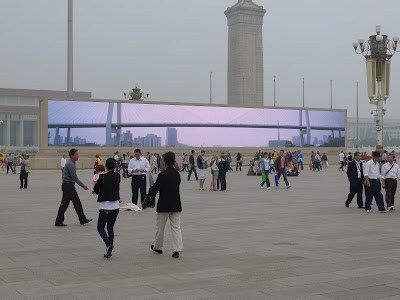 |
| Aaahhhhhhhh. |
Now, cough like the popcorn just got torched in the microwave or you power-bonged some harsh weed. Why? Today at the Yellow River Chronicles we are going to talk about our least favorite place to visit: Reality. Enter, the Great Air Quality question in the PR of C.
So here's the question we have been asked many times about the PR of C. How good/bad is the air in China?
 |
| Another sunny day on Tienanmen Square. |
The air here in China, as measured by the Chinese air measurement authorities, is very good, and in fact, improving. Here are the facts from China Daily, published 12/19/2011:
274 Days of Blue Sky in Beijing in 2011:
BEIJING - As of Saturday, Beijing had enjoyed 274 days of "blue sky" in 2011, fulfilling its annual target ahead of schedule, an official at the city's environmental protection bureau said on Saturday.Beijing experienced an overall decline in the concentration of various pollutants in 2011, said Zhuang Zhidong, deputy director of the bureau.The concentration of PM10, or particulate matter of less than 10 micrometers, decreased to 114 micrograms a cubic meter this year, the lowest in four years, according to the bureau.The city's overall air quality was better than last year, with 22 more days of Grade I air quality, Zhuang said.Beijing uses a five-grade classification of air quality on the basis of pollution indices, with Grade I being the best and Grade V the worst.Days with Grade I or II air quality are considered "blue sky days."However, Beijing also experienced several days of poor air quality as a result of adverse weather. Factors such as weaker winds and a rise in humidity are unsuitable for the dispersal of atmospheric pollutants, according to the bureau.
Air quality monitoring in Beijing made headlines recently due to public debate over different standards of measurement. (YRC emphasis)China currently uses PM10 to measure air quality, but the public has urged government authorities to apply the tighter PM2.5 standard, which measures finer matter that is considered more hazardous to human health as it can go deeper into the lungs.The Ministry of Environmental Protection said it has been reviewing the standards.It said that a new index standard, which would include PM2.5 and ozone density, is scheduled to be fully implemented nationwide in 2016, with pilot projects in certain regions ahead of the national deadline.
So You're Telling Me It's Good Air, Comrade.
Good to know, right, pumpkins? Breath deep. There are as many blue-sky days in Beijing as there are in Aspen, Colorado, for example. However, just so you know, the Chinese government has a measurement system focusing on the 10-micron standard, which measures the important BIG particles, we figure.
Many others, however, seem to think that its the small particles, like 2.5 micron, that are important. So, outside the PR of C, there are multiple reports from every news source on the planet which record that Beijing and many cities in China have air quality close to the exhaust from an ancient coal-fired generator at a big chemical refinery...that is on fire.
In This Case, Red is Bad and So is the Air, Comrades.
 |
| WHO data. Over 20 mcg is bad... |
Take this article for example from Shanghaiist:
It's no news that China's air pollution is bad. In fact if this NASA map (courteously provided above by your elite YRC photo staff) of PM2.5 levels is anything to go by, Eastern China has it the worst in the entire world. But why is the air pollution in some Chinese cities is simply bad (like Guangzhou) while others are super bad (like Beijing?) And which provinces are actually doing anything about it?Enter the Americans with Their Rooftop Air Quality Monitors:
Greenpeace recently took air quality statistics from China's Ministry of Environmental Protection and lined up 28 important cities located in the country's economic powerhouse regions to reveal what exactly is going on:
Beijing's air is really, really bad (duh), but so is Nanjing's and Hangzhou's
Beijing had the dubious honour of landing itself at the bottom of the 28 cities when it came to comparing PM10 levels. In 2010 the city exceeded World Health Organization standards for PM10 by a whopping 605%, hitting an average of 121 ug/m3 for PM10 (the WHO recommends a maximum of 20 ug/m3). Joining Beijing was Nanjing at number 27, and Hangzhou not far behind.
The plot thickens as the air darkens. Remember the data cited above is provided by China's Ministry of Environmental Protection. The U.S. embassy in Beijing has provided air quality readings to the public for years now. Why, we do not know, but maybe they were just....curious. However, this has been a source of conflict between the two nations because the American data is grittier, so to speak.
This from the New York Times:
The Chinese government has monitored exposure levels in 20 cities and 14 other sites, reportedly for as long as five years, but has kept the data secret.
It sought 18 months ago to silence the American Embassy in Beijing as well, arguing that American officials had insulted the Chinese government by posting readings from the PM 2.5 monitor atop the embassy on Twitter. A Foreign Ministry official warned that the embassy’s data could lead to “social consequences” in China and asked the embassy to restrict access to it. The embassy refused, and Chinese citizens now translate and disseminate the readings widely.
Now....on to Shanghai.
 |
| Official photo of Shanghai taken from official YRC offices |
But what about Shanghai, the city of dreams?
Our loyal Yellow River Chronicle readers will be pleased to know that we Shanghai residents now have access to the same monitoring data provided by the U.S. embassy in Beijing. However, according to the Shanghai air monitoring authorities....it could be wrong.
US data clouds Shanghai air readings
Wednesday, May 16, 2012
The United States consulate in Shanghai has begun issuing its own pollution data, giving a much darker assessment of air quality than government statistics.
Hourly data from a monitoring device in the consulate compound is being posted online and on Twitter.
And throughout yesterday morning, air quality was classified as "unhealthy," even as the local environment bureau called conditions "good."
The discrepancy raised concerns among local residents.
"I firmly believe the US data should be trusted," blogger Xiao She posted. " It's beyond imagination ... that our monitoring center said air quality is good when it looks full of dust."
Shanghai officials blamed different measurement standards and said the US figures only relate to a "limited area around the consulate."
Most mainland cities base air-quality information on particles of 10 micrometers or larger, known as PM10, and do not take into account finer particulates that experts say are most harmful to health. But the US consulate figures, like those already being issued by Washington's embassy in Beijing, do monitor the smaller particles known as PM2.5.
State media said Shanghai will release readings that include PM 2.5 particulates from next month.
AGENCE FRANCE-PRESSE
Well, gosh darn it, is the the air here in the 'Hai good or bad?
We were startled to learn that the Chinese government, under pressure from the Chinese citizenry, has recently agreed to publish new air-pollution standards, using some of the international standards.
This from the Associated Press, on the recent release of the data from Beijing.
Steven Andrews, an environmental consultant who has studied Beijing's pollution data since 2006, said he was "already a bit suspicious" of Beijing's PM2.5 data. Within the 24-hour period to noon Saturday, Beijing reported seven hourly figures "at the very low level" of 0.003 milligrams per cubic meter.And so the air quality question leads to one more question:
"In all of 2010 and 2011, the U.S. Embassy reported values at or below that level only 18 times out of over 15,000 hourly values or about 0.1 percent of the time," said Andrews. "PM2.5 concentrations vary by area so a direct comparison between sites isn't possible, but the numbers being reported during some hours seem surpisingly low."
The Beijing center had promised to release PM2.5 data by the start of the Chinese Lunar New Year on Monday. It has six sites that can test for PM2.5 and 27 that can test for the larger, coarser PM10 particles that are considered less hazardous. The center is expected to buy equipment and build more monitoring sites to enable PM2.5 testing.
Beijing wasn't expected to include PM2.5 in its daily roundups of the air quality anytime soon. Those disclosures, for example "light" or "serious," are based on the amount of PM10, sulfur dioxide and nitrogen dioxide in the air.
Beijing interprets air quality using less stringent standards than the U.S. Embassy, so often when the government says pollution is "light," the embassy terms it "hazardous."
 |
| Photo courtesy of The Beijinger, who stole it from somebody else |
We must confess we do not know who is right on this air-monitoring disconnect (we have a few ideas). But as we always say, why take chances?
We are going to acquire a few industrial-strength air scrubbers, wear them on the Metro or out on the town, and you know, man, make a fashion statement out it, man. After all, we can't hold our breath that long...


No comments:
Post a Comment